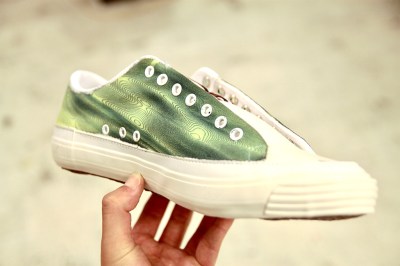[Shih Wei Chieh] has built a laser cyanotype printer for fabrics. You know, for art!
 How do you get an inkjet head on a shoe or a couch? Most printing processes require a flat surface to print. But hearkening back to the days when a blueprint was a blueprint, a mixture of an iron salt and an acid are mixed and applied to a surface an interesting reaction occurs when the surface is exposed to UV light. The chemicals react to form, of all things, prussian blue. After the reaction occurs simply washing away the remaining chemicals leaves a stable print behind.
How do you get an inkjet head on a shoe or a couch? Most printing processes require a flat surface to print. But hearkening back to the days when a blueprint was a blueprint, a mixture of an iron salt and an acid are mixed and applied to a surface an interesting reaction occurs when the surface is exposed to UV light. The chemicals react to form, of all things, prussian blue. After the reaction occurs simply washing away the remaining chemicals leaves a stable print behind.
[Shih Wei Chieh] uses two galvanometers and a laser to cure the fabric. He uses a slightly newer process which reduces the exposure time required. This lets him print very large pictures, but also on uneven surfaces. As you can see in the video, viewable after the break, the effect is very pretty. There’s a new way to have the coolest pen plotter on the block.
















What about using DLP to expose it? Would that work faster, or does it need the intensity of a laser to do the print?
The process works best with UV light, but I suppose a DLP could be modified to work.
Probably less focus issues with a galvo scanned laser too. Might be more forgiving on an undulating surface.
Indeed the focusing issues were my first thought on reading the comment (not that DLP’s are bad for focus).
But DLP is definately the way to go if you want to use this method to print many large flat sheets. Its easy to hang a sheet in the right place and print huge with a DLP doing whole sheets potentially in one pass. This would be alot easier at least for hackers than building or buying (and then storing when not in use) a huge x-y inkjet mechanism.
Oh totally.
We use galvo scanned lasers every day but there’s no getting round the vector type nature of dragging a spot round.
And when I mention DLP, I mean after the UV filters are removed.
Maybe you should build a removable UV filter to put over the lens to line up the picture, get the prefect focus, etc and then zap it with the UV (in a dark room for I assume half an hour given the intensity of the UV vs. a laser.)
LED or incandescent lightbulbs probably make a reasonable safelight, especially the LED if it’s actually mostly sensitive to UV.
Cyanotypes do need quite a bit of light to expose – even direct sunlight takes a minute or three. I bought a 60W black light to do prints without depending on the sun, and it takes ~10 minutes, and it’s only 3 in from the paper.
You might a different wavelength then…
Quite probably! I still don’t think a DLP projector 6-10 ft from the target is going to develop the image in a very short time though…